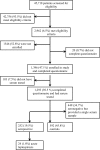Risk factors for human acute leptospirosis in northern Tanzania
- PMID: 29879114
- PMCID: PMC5991637
- DOI: 10.1371/journal.pntd.0006372
Risk factors for human acute leptospirosis in northern Tanzania
Abstract
Introduction: Leptospirosis is a major cause of febrile illness in Africa but little is known about risk factors for human infection. We conducted a cross-sectional study to investigate risk factors for acute leptospirosis and Leptospira seropositivity among patients with fever attending referral hospitals in northern Tanzania.
Methods: We enrolled patients with fever from two referral hospitals in Moshi, Tanzania, 2012-2014, and performed Leptospira microscopic agglutination testing on acute and convalescent serum. Cases of acute leptospirosis were participants with a four-fold rise in antibody titers, or a single reciprocal titer ≥800. Seropositive participants required a single titer ≥100, and controls had titers <100 in both acute and convalescent samples. We administered a questionnaire to assess risk behaviors over the preceding 30 days. We created cumulative scales of exposure to livestock urine, rodents, and surface water, and calculated odds ratios (OR) for individual behaviors and for cumulative exposure variables.
Results: We identified 24 acute cases, 252 seropositive participants, and 592 controls. Rice farming (OR 14.6), cleaning cattle waste (OR 4.3), feeding cattle (OR 3.9), farm work (OR 3.3), and an increasing cattle urine exposure score (OR 1.2 per point) were associated with acute leptospirosis.
Conclusions: In our population, exposure to cattle and rice farming were risk factors for acute leptospirosis. Although further data is needed, these results suggest that cattle may be an important source of human leptospirosis. Further investigation is needed to explore the potential for control of livestock Leptospira infection to reduce human disease.
Conflict of interest statement
The authors have declared that no competing interests exist.
Figures
References
-
- Crump JA, Morrissey AB, Nicholson WL, Massung RF, Stoddard RA, Galloway RL, et al. Etiology of severe non-malaria febrile illness in Northern Tanzania: a prospective cohort study. PLoS Negl Trop Dis. 2013;7(7):e2324 doi: 10.1371/journal.pntd.0002324 ; PubMed Central PMCID: PMCPMC3715424. - DOI - PMC - PubMed
-
- Maze MJ, Biggs HM, Rubach MP, Galloway RL, Cash-Goldwasser S, Allan KJ, et al. Comparison of the estimated incidence of acute leptospirosis in the Kilimanjaro Region of Tanzania between 2007–08 and 2012–14. PLoS Negl Trop Dis. 2016;10(12):e0005165 doi: 10.1371/journal.pntd.0005165 ; PubMed Central PMCID: PMCPMC5135036. - DOI - PMC - PubMed
-
- Mwachui MA, Crump L, Hartskeerl R, Zinsstag J, Hattendorf J. Environmental and behavioural determinants of leptospirosis transmission: a systematic review. PLoS Negl Trop Dis. 2015;9(9):e0003843 doi: 10.1371/journal.pntd.0003843 ; PubMed Central PMCID: PMCPMC4574979. - DOI - PMC - PubMed
-
- Levett PN. Leptospirosis. Clin Microbiol Rev. 2001;14(2):296–326. doi: 10.1128/CMR.14.2.296-326.2001 - DOI - PMC - PubMed
Publication types
MeSH terms
Grants and funding
- BB/L018845/1/BB_/Biotechnology and Biological Sciences Research Council/United Kingdom
- R25 TW009343/TW/FIC NIH HHS/United States
- R01 AI121378 /NH/NIH HHS/United States
- R01TW009237 /NH/NIH HHS/United States
- R25 TW009337/TW/FIC NIH HHS/United States
- R25 TW009343 /NH/NIH HHS/United States
- BB/L018926/1/BB_/Biotechnology and Biological Sciences Research Council/United Kingdom
- K23 AI116869/AI/NIAID NIH HHS/United States
- WT_/Wellcome Trust/United Kingdom
- R01 AI121378/AI/NIAID NIH HHS/United States
- R01 TW009237/TW/FIC NIH HHS/United States
- T32 AI007392/AI/NIAID NIH HHS/United States
- AI007392 /NH/NIH HHS/United States
- U01 AI062563/AI/NIAID NIH HHS/United States
- MC_PC_16045/MRC_/Medical Research Council/United Kingdom
- U01 AI062563 /NH/NIH HHS/United States
- R25 TW009337 /NH/NIH HHS/United States
LinkOut - more resources
Full Text Sources
Other Literature Sources



